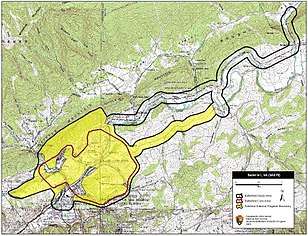First Battle of Saltville
Camp Nelson Heritage National MonumentThe First Battle of Saltville (October 2, 1864) was fought near the town of Saltville, Virginia, during the American Civil War. The battle over an important saltworks in town was fought by both regular and Home Guard Confederate units against regular Union troops, which included two of the few black cavalry units of the United States Colored Troops. The Union troops were led by Brig. Gen. Stephen G. Burbridge, then commander of US forces in the Commonwealth of Kentucky.[3]

Confederates murdered both black and white wounded soldiers after the battle, in what has been called the Saltville Massacre.[3]
Saltville Massacre
The battle was a Confederate victory. It has become known primarily for the Confederate massacre afterward of both white and black wounded Union troops. Both Confederate soldiers and irregular guerrilla forces under the notorious Champ Ferguson murdered white and black Union soldiers, on the battlefield and later some wounded who were being treated at the field hospital set up at nearby Emory and Henry College. A Union surgeon reported that 5-7 black soldiers and Elza Smith, a white lieutenant, were murdered at the hospital.[3] Ferguson was tried after the war in Nashville, Tennessee, for these and other non-military killings. He was found guilty and executed on October 29, 1865.[3]
Confederate Brig. Gen. Felix Huston Robertson had bragged to another officer that "he had killed nearly all the Negroes."[4] William C. Davis, in his book An Honorable Defeat. The Last Days of the Confederate Government (2001), says that Robertson personally "join(ed) in the act of villainy", although he escaped prosecution. When General Robert E. Lee learned of Robertson's conduct, he communicated to General John C. Breckinridge, Commander of the Department of East Tennessee and West Virginia, his dismay "that a general officer should have been guilty of the crime you mention" and instructed Breckinridge to "prefer charges against him and bring him to trial."[5]
Estimates of the number of men massacred at Saltville vary. Thomas Mays, in his book The Saltville Massacre (1995), argued that 46 Union soldiers were killed.[3] [6]An analysis of the National Archives records by Bryce Suderow, Phyllis Brown, and David Brown concluded that 45-50 members of the 5th and 6th U.S. Colored Cavalry (USCC) were murdered by Confederates.[4] William Marvel had earlier analyzed the same records and concluded in 1991 that "Five black soldiers, wounded and helpless were definitely murdered at Saltville on October 3, and as many as seven more may have suffered the same fate there that day."[7] He said as many as two dozen Union men may have been murdered.[3]
Second battle
The Second Battle of Saltville took place two months later at Saltville.
Battlefield preservation
The Civil War Trust (a division of the American Battlefield Trust) and its partners have acquired and preserved 107 acres (0.43 km2) of the Saltville battlefields.[8]
See also
- Saltville Battlefields Historic District
- Second Battle of Saltville
- 5th United States Colored Cavalry
- Champ Ferguson-hanged in October 1865 on murder charges.
- John C. Breckinridge, attempted to have Felix Huston Robertson tried for killing black soldiers.
- Salt in the American Civil War
- Camp Nelson Heritage National Monument
References
- CWSAC Report Update
- National Park Service Battle Summary
- Encyclopedia Virginia: "Saltville During the Civil War"
- "Was there a Saltville Massacre in 1864?" David Brown's analysis Archived 2010-04-30 at the Wayback Machine
- McKnight, Brian D. Contested Borderland: Civil War in Appalachian Kentucky and Virginia. University Press of Kentucky, 2006. p. 211
- Mays, Thomas Davidson, 1960-. The price of freedom : the battle of Saltville and the massacre of the Fifth United States Colored Cavalry. OCLC 26567207.CS1 maint: multiple names: authors list (link)
- Marvel, William (August 1991). "What Makes a Massacre?". Blue & Gray Magazine: 52–53.
- American Battlefield Trust "Saved Land" webpage. Accessed May 29, 2018.
Further reading
- Bush, Bryan S. (2008). Butcher Burbridge: Union General Stephen Burbridge and His Reign of Terror Over Kentucky. Morley, Missouri: Acclaim Press. ISBN 0-9798802-5-4.
- Davis, William C., and James I. Robertson. Virginia at War: 1862. Lexington: University Press of Kentucky, 2007.
- Duncan, Richard R. Lee's Endangered Left: The Civil War in Western Virginia. Baton Rouge: Louisiana State University Press, 1998.
- Glatthaar, Joseph T. Forged in Battle: The Civil War Alliance of Black Soldiers and White Officers. New York: The Free Press, 1990.
- Mays, Thomas. The Saltville Massacre, Abilene, Texas: State House Press, 1995
- Mosgrove, George Dallas. Kentucky Cavaliers in Dixie, Reminiscences of a Confederate Cavalryman, Louisville, KY: Courier-Journal Job Publishing Co., 1895; republished 1957 by Mc Cowart-Mercer Press, Jackson, TN; that version reprinted in 1999 by University of Nebraska Press.
External links
- "Saltville, Virginia", Coverage by Harper's Weekly; continued here
